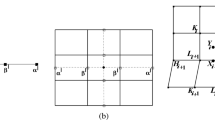Abstract
This paper presents a \(\sqrt2\)subdivision scheme for quadrilateral meshes that can be regarded as an extension of a 4-8 subdivision with new subdivision rules and improved capability and performance. The proposed scheme adopts a so-called \(\sqrt2\)split operator to refine a control mesh such that the face number of the refined mesh generally equals the edge number and is thus about twice the face number of the coarse mesh. Smooth rules are designed in reference to the 4-8 subdivision, while a new set of weights is developed to balance the flatness of surfaces at vertices of different valences. Compared to the 4-8 subdivision, the presented scheme can be naturally generalized for arbitrary control nets and is more efficient in both space and computing time management. Analysis shows that limit surfaces produced by the scheme are C4 continuous for regular control meshes and G1 continuous at extraordinary vertices.
Similar content being viewed by others
References
Ball AA, Storry DJT (1988) Conditions for tangent plane continuity over recursively generated B-spline surfaces. ACM Trans Graph 7(2):83–102
Bolz J, Schröder P (2001) Rapid evaluation of Catmull-Clark subdivision surfaces. In: Proceedings of Web3D’02, Tempe, AZ, 24–28 February 2002. ACM Press, New York, pp 11–17
Catmull E, Clark J (1978) Recursively generated B-spline surfaces on arbitrary topological meshes. Comput Aided Des 10(6):350–355
Doo D, Sabin M (1978) Behaviour of recursive division surfaces near extraordinary points. Comput Aided Des 10(6):356–360
Dyn N, Levin D, Gregory JA (1990) A butterfly subdivision scheme for surface interpolatory with tension control. ACM Trans Graph 9(2):160–169
Habbib A, Warren Joe (1999) Edge and vertex insertion for a class of.C1 subdivision surfaces. Comput Aided Geom Des 16(4):223–247
Halstead M, Kass M, DeRose T (1993) Efficient, fair interpolation using Catmull-Clark surfaces. In: Proceedings of ACM SIGGRAPH, California, August 1993. Comput Graph 20:35–44
Kobbelt L (1996) Interpolatory subdivision on open quadrilateral nets with arbitrary topology. In: Proceedings of EUROGRAPHICS, Poitiers, France, 26–30 August 1996, Comput Graph Forum 15(3):409–410
Kobbelt L (2000) \(\sqrt3\)-Subdivision. In: Proceedings of ACM SIGGRAPH, New Orleans, 23–28 July 2000. Comput Graph 27:103–112
Labsik U, Greiner G (2000) Interpolatory \(\sqrt3\)-subdivision. In: Proceedings of EUROGRAPHICS, Interlaken, Switzerland, 21–25 August 2000. Comput Graph Forum 19(3):131–138
Lane J, Riesenfeld R (1980) A theoretical development for the computer generation, display of piecewise polynomial surfaces. IEEE Trans Patt Anal Mach Intell 2:35–46
Loop C (1987) Smooth subdivision surfaces based on triangles. Master’s thesis, University of Utah, Department of Mathematics
Maillot J, Stam J (2001) A unified subdivision scheme for polygonal modeling. Comput Graph Forum 20(3):471–479
Oswald P, Schröder P (2003) Composite primal/dual \(\sqrt3\)-subdivision schemes. Comput Aided Geom Des 20(3):135–164
Peters J, Reif U (1997) The simplest subdivision scheme for smoothing polyhedra. ACM Trans Graph 16(4):420–431
Peters J, Reif U (1998) Analysis of algorithms generalizing B-spline subdivision. SIAM J Numer Anal 35(2):728–748
Prautzsch H (1998) Smoothness of subdivision surfaces at extraordinary points. Adv Comput Math 9(3–4):377–389
Prautzsch H, Umlauf G (1998a) A G2-subdivision algorithm. In: Farin G, Bieri H, Brunnet G, DeRose T (eds) Geometric modeling, computing supplement 13. Springer, Berlin Heidelberg New York, pp 217–224
Prautzsch H, Umlauf G (1998b) Improved triangular subdivision schemes. In: Wolter F-E, Patrikalakis NM (eds) Proceedings of CGI ’98, Hannover, Germany, 22–24 June 1998, pp 626–632
Prautzsch H, Umlauf G (2000) A G1 and a G2 subdivision scheme for triangular nets. Int J Shape Model 6(1):21–35
Reif U (1995) A unified approach to subdivision algorithms near extraordinary vertices. Comput Aided Geom Des 12(2):153–174
Stam J (1998a) Exact evaluation of Catmull–Clark subdivision surfaces at arbitrary parameter values. In: Proceedings of ACM SIGGRAPH, Orlando, FL, 19–24 July 1998. Computer Graphics 25:395–404
Stam J (1998b) Evaluation of loop subdivision surfaces. In: Proceedings of ACM SIGGRAPH, Computer Graphics, CD-ROM
Stam J (2001) On subdivision schemes generalizing uniform B-spline surfaces of arbitrary degree. Comput Aided Geom Des 18(5):383–396
Umlauf G (2000) Analyzing the characteristic map of triangular subdivision schemes. Constr Approx 16(1):145–155
Velho L, Zorin D (2001) 4-8 Subdivision. Comput Aided Geom Des 18(5):397–427
Warren J, Weimer H (2001) Subdivision methods for geometric design: a constructive approach. Morgan Kaufmann, New York
Zorin D (1998) Stationary subdivision and multiresolution surface representation. Ph.D Thesis, California Institute of Technology, Pasadena, CA
Zorin D (2000a) Smoothness of stationary subdivision on irregular meshes. Constr Approx 16(3):359–397
Zorin D (2000b) A method for analysis of C1-continuity of subdivision surfaces. SIAM J Numer Anal 37(5):1677–1708
Zorin D, Schröder P (2001) A unified framework for primal/dual quadrilateral subdivision scheme. Comput Aided Geom Des 18(5):429–454
Author information
Authors and Affiliations
Corresponding author
Rights and permissions
About this article
Cite this article
Li , G., Ma , W. & Bao , H. √2 Subdivision for quadrilateral meshes. Visual Comp 20, 180–198 (2004). https://doi.org/10.1007/s00371-003-0238-7
Published:
Issue Date:
DOI: https://doi.org/10.1007/s00371-003-0238-7




